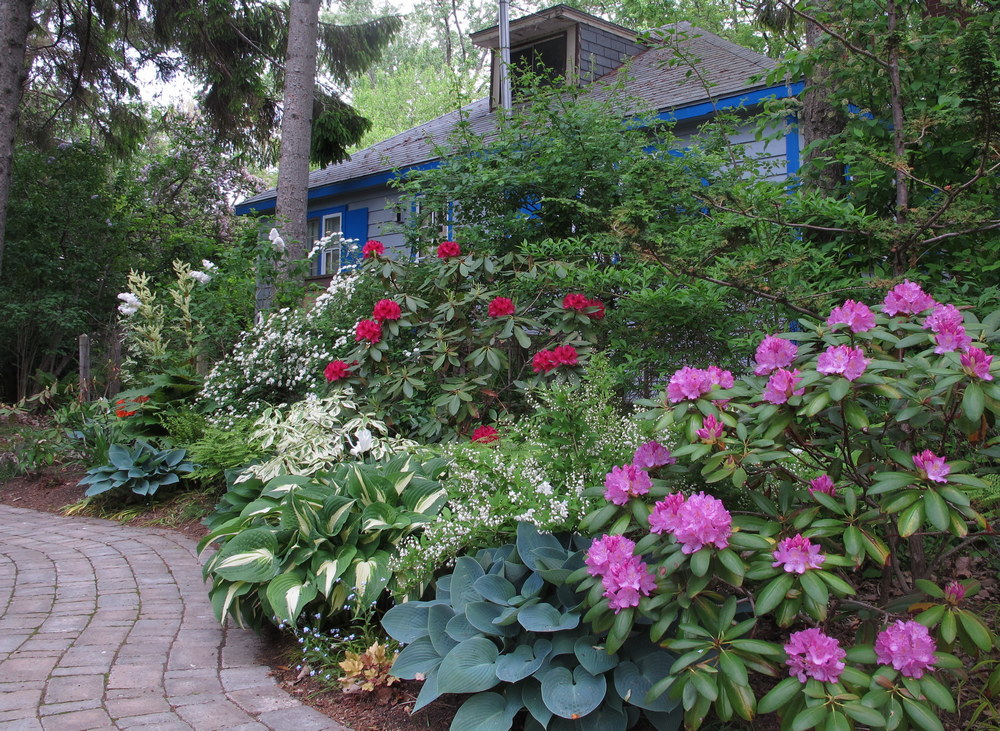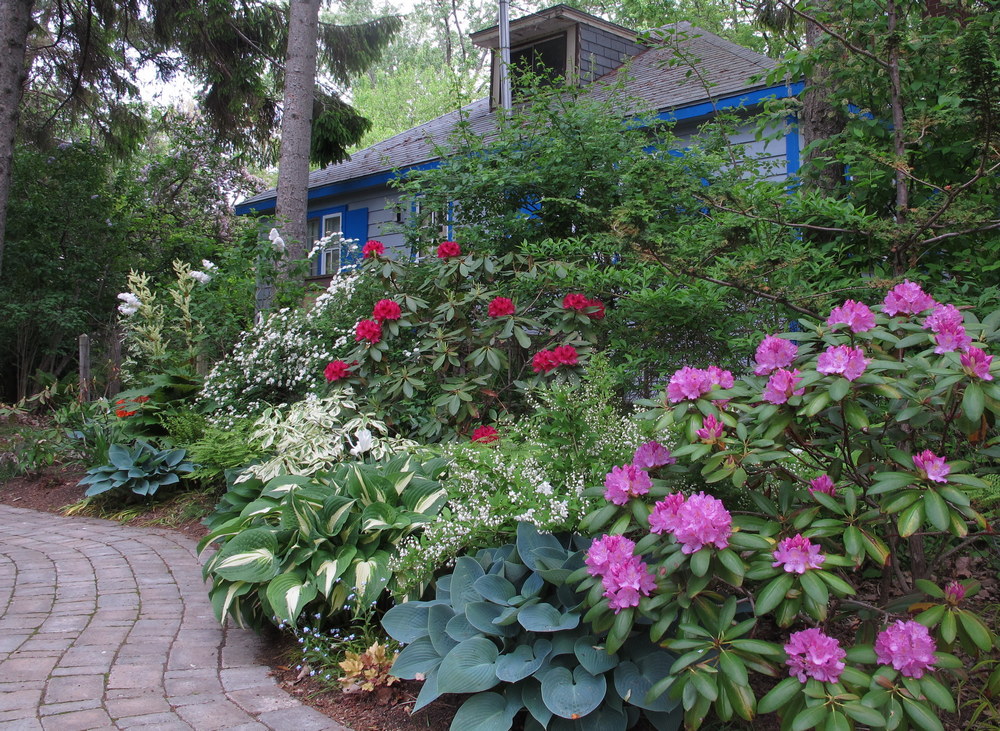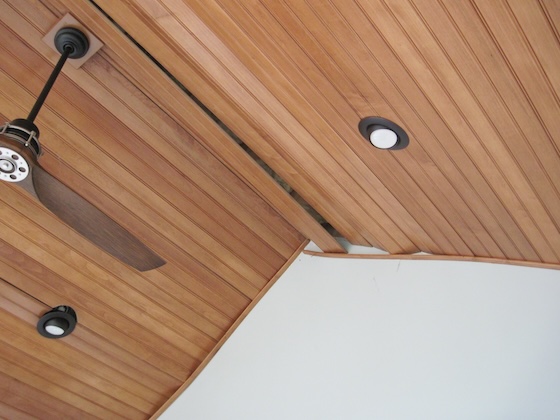

In my recent post covering Henry Mitchell’s advice about lawns and alternatives thereto, I promised to next share his ideas on designing gardens for lower maintenance, also from The Essential Earthman starting at page 79. He introduces the topic: “The saving of time and labor in the garden is not important if you have an endless supply of both, but many gardeners find themselves unable to keep it all together, as you might say.”
So he has suggestions, especially for medium-sized gardens – up to 1/2 acre – where the gardener has to do it all him or herself. Because size matters: “In big gardens there simply has to be plenty of labor, and in tiny places, 30 by 30 feet, there’s not enough to do.” I’ve illustrated Mitchell with photos of home gardens I’ve visited.
Lawn Edging
“If there is lawn, do not let the grass run up to the edge of rose beds or any other place where hand-trimming will be necessary for a neat effect. Instead, let the lawn come up a grade-level band of stone or concrete so that on the last lap the mower rests partly on the lawn and partly on the stone.”

This border is nicely defined, but the stones don’t make mowing easy.
Easier to mow along, though not quite what Mitchell had in mind.
Reduce Edging with Wide Borders
“Have as few edges to things as possible. Narrow beds have a disproportionate amount of edging; therefore a border 14 feet wide and 100 feet long (with stepping stones to get at things) is easier than a number of small beds separated by brick or grass paths.”

Probably too much edging maintenance for Mitchell.
Paths

“Have no more paths than truly necessary. One path, six feet wide, is best. If it is brick, it should be set in mortar. If it is flagstone, it should be set in mortar. The inexperienced person has no conception at all how many hours can be spent weeding pavement that is not set in concrete and grouted with mortar.
“And while on this subject, take pains with the color of the mortar. White mortar between brick, fieldstone, slate and so on looks awful…. Gravel is absurd. It rarely looks good, is never comfortable, and is ideal for weeds and masochists.”
I bet we can all agree that weeding between pavers is a slog! Also, gravel IS absurd!

Gravel can look pretty cool, but low-maintenance it’s not.

Rock Gardens
“Avoid intensive care projects. Nothing known to man equals a rock garden for labor. Incredibly enough, I have twice seen rock gardens advocated as labor-saving devices, but this only proves that human perversity is boundless. Nothing in all gardening requires so much work for so little return as a rock garden. If the gardener wants lewisias and saxifrages and other rock plants, he should struggle with them in tubs or raised borders, not in a rock garden.”
I love “human perversity is boundless.”
Greenhouses
“Greenhouses may be nice (usually they are a total mess) but the labor of keeping them is substantial….[examples given]. A greenhouse can be endlessly rewarding, but the gardener should be certain he really wants one, and if he really does, then it should be as large as possible, not as small as possible.”
The Right Plants

“Avoid plants that necessarily involve many hours’ labor a year. Irises and roses, to name two, must be hand-weeded and sprayed.
“Wide borders with shrubs (smoke bushes, fringe trees, small plums, pink locusts, mahonias, nandinas, photinias, small junipers or yews or box, hybrid rugosa roses, Japanese maples, azaleas, blueberries, viburnums) and clumps of bulbs like daffodils and tulips; perennials like peonies, Japanese anemonies, baptisias, artemisias, poppies, and so on and on, are less work than borders of annuals or borders of those numerous perennials that must be staked, lifted, replanted every year or two. Hostas, yuccas, and wormwoods of various sorts are also superb, trouble-free creatures. Before planting anything, ask yourself if you will need to stake it, tie it, prune it, spray it, and weigh its beauty against your real commitment to it. Often, one would really prefer peonies.”
It’s interesting to see which shrubs and perennials he recommended (published in 1982), especially citing peonies as low-maintenance. Did he never have to stake his?

Who thinks these peony-packed borders are low maintenance?
Good Foliage

“Gravitate always to plants that have good foliage when not in bloom. Irises, for example, have terrible foliage in summer. The handsomer the foliage of a plant, the less work in making the garden look good.”
Good tip!
Lily Ponds. Really?

“Consider a water lily pool as large as possible. Dollar for dollar and hour for hour of maintenance, the garden lily pool is the best investment of all. But never start such projects without reading books…”
Okay, but suggesting any pond as a low-maintenance design feature seems crazy to me.

rchitecture, especially Benches

“The smaller the garden and the less labor available, the more important the architecture, like a wood bench of first-rate honesty and solidity…A good place to sit in the garden is worth having, and it will count strongly in the design, far more than the frumpy ornaments sometimes acquired.” Agree!
Shapes and Colors
“Keep all outlines bold, over-scaled, plain, rectangular, and keep to gray, black, earth color, except in chairs, if you like to spend 50 hours a year painting them. White leaps out in the garden, but if you like the effect (and in other people’s gardens it can look great) of white fences, white furniture, be prepared to paint.”
I agree with “bold, over-scaled and plain” but rectangular, instead of curves?

An example of straight lines and rectangular shapes in a San Francisco garden. Not great for mowing, and to my eyes, a distraction.

That’s better.
Henry Mitchell on designing for low maintenance originally appeared on GardenRant on September 1, 2023.
The post Henry Mitchell on designing for low maintenance appeared first on GardenRant.






More Stories
Why Should We Think About Our Winter Gardens Right Now?
5 Reasons You Need Snow Removal Services
Green Industry Veteran Nick Jiannas Joins Kress Commercial